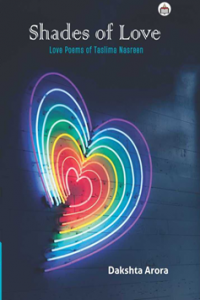Creation and Criticism
ISSN: 2455-9687
(A Quarterly International Peer-reviewed Refereed e-Journal
Devoted to English Language and Literature)
Vol. 07, Joint Issue 26 & 27: July-Oct 2022

Book Review
Shades of Love: Love Poems of Taslima Nasreen
by Dakshta Arora
Dakshta Arora. Shades of Love: Love Poems of Taslima Nasreen. New Delhi: Authorspress, 2022. Pp. 106. Rs. 595/- ISSN: 978-93-5529-023-6.
Reviewed by Abnish Singh Chauhan
Dakshta Arora’s Shades of Love: Love Poems of Taslima Nasreen, which contains criticism of Taslima Nasreen’s love poems, is a good attempt to bring the unexplored love aspects of Nasreen’s poetry. The name of Taslima Nasreen is a well-known name among the literary lovers as well as common men. She is popular because of her banned novel Lajja and it is sad that she is tagged and viewed in the light of this novel. This image has shaded her poetry, particularly love poetry. Though some of her feminist poems are discussed, her love poems remain hidden. Dakshta Arora’s attempt to bring Nasreen’s love poems is really worth praising. Taslima has written most of her poems in Bengali. She has taken Nasreen’s poems, translated by Ashim Chowdhury as the primary source for her criticism. The good point of this book is that she has not mentioned the controversial aspects related to Taslima Nasreen, and, therefore, the author has been demonstrated as a love poet who has chosen her own experiences in love and life for her poems.
The book begins with the two excerpts revealing the very essence of Taslima Nasreen’s poems. Besides bibliography and some facts, it contains six chapters, i.e. the poet in the making, love in theory, shades of love, pain in love, poetic idiom and end in the end. The first chapter is— ‘The Poet in the Making’ discussing the factors responsible for making her a love poet. She has used her own experiences, which become clues related to every woman. What makes her a poet is her empathic attitude making her “feel the pain and suffering of others as her own pain and suffering.” The second chapter— ‘Love in Theory’ explores theory of love theoretically defining love and the various perspectives of philosophers and poets. The third chapter is important as it highlights the different shades of love, including physical, mental, emotional and spiritual aspects. The third chapter is— ‘Pain in Love, Love in Pain: Desire and Despair’, which unfolds the various unexplored dimensions of love when it is in pain. The fifth chapter is— ‘Poetic Idiom: Phrases and Figures.’ This chapter presents love in various shades through phrases, figures and images.
The critic has explored the technical aspects in the poems of Taslima Nasreen and shown how she has employed them to express her feelings of love, life, despair and loneliness. Some of the poems that are translated by Taslima herself and by Ashim Chowdhury are compared to make difference and beauty of emotion and feelings. Taslima Nasreen’s confessional mode is also emphasized. Writing about the poetic art, the critic writes: “Her poetic art is simple, yet forceful. The poetic idiom that she employs is the poetic idiom of every woman. Here is her victory in giving expression in an idiom, which is not only simple, but expressive and effective” (79). The last chapter— ‘End in the End: Love Continues’ offers the essence of all the previous chapters. The critic offers her final submission about Taslima Nasreen when she states in a declarative mode: “Taslima Nasreen sees an end in the end— the end of love that will make her alive in the patriarchal world where she has to find her own space on mutual understanding in life and love. Love continues…” (87).
The book contributes much to the field of criticism, particularly related to Taslima Nasreen, as it presents the positive and different image of Taslima Nasreen. It would be better if the critic has added one more chapter related to the comparative study of her poems with the poems of Kamala Das, Sylvia Plath and Emily Dickinson. In brief, the book is useful and interesting for even a general reader, who, if continues to read it once, will finish the whole book of 106 pages and feel satisfied when he closes it while feeling the fragrance of love of Nasreen’s poems. The critic has all the appreciation for presenting Taslima Nasreen in a new avatar of a love poet.
About the Reviewer:
 Dr Abnish Singh Chauhan (1979), the editor of two online journals– Creation and Criticism and IJHER and a Hindi magazine– Poorvabhas (पूर्वाभास), is presently serving as a Professor (English) & Founding Dean/Principal, BIU College of Humanities & Journalism, Bareilly Iinternational University, Bareilly, U.P. He has authored a number of books including Swami Vivekananda: Select Speeches, Speeches of Swami Vivekananda and Subhash Chandra Bose: A Comparative Study, The Fictional World of Arun Joshi: Paradigm Shift in Values and Tukda Kagaz Ka (A collection of Hindi Lyrics). He can be contacted at abnishsinghchauhan@gmail.com.
Dr Abnish Singh Chauhan (1979), the editor of two online journals– Creation and Criticism and IJHER and a Hindi magazine– Poorvabhas (पूर्वाभास), is presently serving as a Professor (English) & Founding Dean/Principal, BIU College of Humanities & Journalism, Bareilly Iinternational University, Bareilly, U.P. He has authored a number of books including Swami Vivekananda: Select Speeches, Speeches of Swami Vivekananda and Subhash Chandra Bose: A Comparative Study, The Fictional World of Arun Joshi: Paradigm Shift in Values and Tukda Kagaz Ka (A collection of Hindi Lyrics). He can be contacted at abnishsinghchauhan@gmail.com.


